


NISS uncovered a gem when Andreea was hired as a research associate! Having always had an interest and aptitude for mathematics, it wasn’t until she was an undergraduate at Colorado State University that she originally realized that statistics was more than just a subfield of mathematics. From that point on there was no stopping Andreea!
Why statistics? Why data?
“I’ve always liked numbers and data, to analyze them and to find patterns.”
Early, during her bachelor’s studies, a challenging graduate-level statistics course in data analysis and regression confirmed her decision that statistics was an area that she wanted to master. Graduate-level statistics courses prompted the realization that in reality there may not be ‘exact’ paths to arrive to a solution. Instead, specific observations could lead to broad generalizations.
She received her Bachelor’s degree in Mathematics (with a double concentration in Mathematics of Information and Statistics) from Colorado State University. Then, prior to her graduate research in statistics, she worked as an undergraduate research assistant in statistics on a very important problem in structural biology, investigating autocorrelation structure in the detector plane and in the radial averages, a result of the Small-angle X-ray scattering (SAXS) technique (a technique for obtaining low-resolution structural information about biological macromolecules). She then earned her Masters and Ph.D. in Statistics, from the Department of Statistics at Iowa State University.
In her doctoral dissertation, she constructed small area predictions of means for a nonlinear unit-level model, when covariate means are subject to measurement error. In addition, she developed a fast, double bootstrap method for estimating the variance of the small area predictions and proposed a method of constructing bootstrap confidence intervals for the prediction means at a desired confidence level. These novel contributions to the small area estimation research provided new and efficient tools for a class of complex models, and turned the heads of various agencies and policy makers.
Becoming a NISS Research Associate
Believe it or not, Andreea responded to a NISS flyer posted in the graduate students lounge at Iowa State University’s Department of Statistics! “One of the qualifications was my main area of expertise, ‘small area estimation’, so I immediately decided to apply for the position and learn more about it.”
Her original research as a student helped to focus her entry into the statistics profession. Andreea joined NISS as a Research Associate in August 2015. Since then, she has been involved in reviews, research and other activities as part of the USDA’s National Agricultural Statistics Service (NASS) project teams.
At NASS, Andreea developed Hierarchical Bayes models for improving estimation of agricultural quantities by incorporating survey data and auxiliary data. The model-based estimates are more reliable than the survey-based estimates at fine disaggregation levels, and meet benchmarking constraints with aggregated levels (for example, counties to states, or states to nation). These novel models contribute to the small area estimation research and provide reliable, transparent and reproducible methods for NASS programs that require fine domain-level estimation. Moreover, the models provide means of constructing official estimates and associated distributions (not just point estimates).
Based her work to date, she has authored or co-authored 17 posters, 33 presentations, 13 proceedings papers and eight peer-reviewed papers. She has organized or chaired sessions at FCSM 2018, JSM 2018 and JSM 2014, served as a reviewer of NASS peers work and as a reviewer for four journals. She has also served as a member of the NASS team at the NAS CNSTAT panel evaluating the NASS end-of-season crops and cash rental rates estimation programs and as an expert member on the Small Area Estimation panel evaluating the Westat / NCE’s Program for the International Assessment of Adult Competencies study.
Her work has been recognized with awards from Colorado State University, Iowa State University, the National Science Foundation, the American Statistical Association, the Society for Advancement of Chicanos/Hispanics and Native Americans in Science, Wiley, and NASS.
Experience on many levels
Working with NASS Andreea also realized that thoroughly analyzing complex surveys and multiple data sources relies on team work. “At NASS I am fortunate to collaborate with colleagues from different backgrounds such as agriculture, geography, programming and statistics.”
“I learned about the importance of collaboration with subject-matter experts. I have been involved in modeling survey data, administrative data, remote sensing and weather data trying to find and explain patterns. In these instances, subject matter knowledge, for instance, in crop growth and development, is necessary if you want to determine the practical significance of, for example, weather variables in the statistical model.”
“I also learned about the importance of official statistics and the corresponding needs and usages of their users. One of the greatest challenges is the communication of the measures of uncertainty to users and policy-makers. The allocation of funds decided under programs that utilize agricultural official statistics don’t need to be based on decisions made using point estimates only.”
